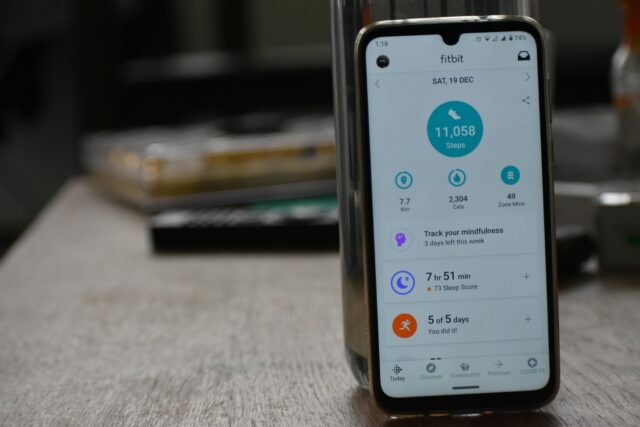Nowadays, AI is way smarter than we think and also captures our lives with a blink of an eye. Earlier, we could not imagine that AI would help us to know about our blood oxygen level; are you still wondering? Yes, have you ever heard about the smart watch brand “Fitbit?”
Fitbit is a clever watch brand which is presently integrated with its Fitbit Blood Oxygen Saturation
Feature, where your smartwatch is hooked up to a cellular application set up on your smart phone and that watch routinely tracks your spo2 levels, in standard, its blood oxygen level for adults or any man or woman.
How about Fitbit Blood Oxygen Saturation?
Every cell in the human body needs oxygen to function. Blood oxygen saturation, or SpO2, is the proportion of oxygen in a person’s blood and is a measure of how well the body transfers oxygen from the lungs to the cells.
Fitbit Blood Oxygen Saturation – This makes it easy to monitor this indicator. Fitbit users can choose to wear the device to bed or wake up.
The Fitbit app that syncs the device shows SpO2 levels from the night before and in fitness tracking devices Users can also see trends in blood oxygen saturation… Use the Fitbit app or Fitbit support website to learn more about this metric.
SpO2 monitoring helps individuals become more aware of their blood oxygen saturation patterns during sleep. In addition, users can observe if their readings are higher or lower than their baseline values. Understanding the level of oxygen delivery throughout the body can help consumers understand their general health.
How does Fitbit Blood Oxygen Saturation ML work?

A red infrared light sensor on the back of the Fitbit device is used to measure SpO2. The sensor measures the amount of oxygen in the blood by shining red and infrared light on the skin and blood vessels. Then calculate the amount of light that is reflected. Machine learning (ML) is used to estimate SpO2 and ensure a safe level. Reliability of blood oxygen readings
Here’s how AI standards influenced the development of Fitbit Blood Oxygen Saturation ML capabilities:
User Privacy and Data Security
One of the center AI concepts is to make sure that person’s privacy is blanketed. Fitbit’s ML features, like sleep monitoring or coronary heart charge tracking, depend on personal fitness statistics. AI principles ensure that these statistics are processed in a way that respects privacy and is saved securely. Fitbit employs encryption and anonymization techniques to safeguard person records at the same time as turning in customized insights without compromising security.
Fairness and Inclusivity
AI should be evolved to gain anybody, and Fitbit’s ML capabilities replicate this principle by means of making sure that the fashions are trained on numerous datasets. This allows us to avoid bias in health-associated insights and tips, making sure they work well for people of various ages, genders, body types, and health stages. For instance, coronary heart rate algorithms are designed to be accurate throughout a huge range of customers, regardless of person variations.
Transparency
AI standards promote transparency, meaning customers have to recognize how their facts are being used and how the AI functions. Fitbit gives users clean facts about how its ML functions work, what information is accumulated, and the way the insights are generated. This helps build consider with customers who depend upon Fitbit to screen their fitness.
Statistical evaluation
AI systems must be accountable and provide reliable results. Fitbit uses rigorous testing and non-stop tracking to ensure that its ML algorithms, as well as pedestrian counts, Sleep tracking or health monitoring, remain accurate after all these years. Fitbit strives to correct any errors or biases that may occur. By maintaining responsibility for AI-powered capabilities.
Sustainability and efficiency
Another key principle of AI is maximizing sustainable and electrically efficient production. Fitbit’s ML functionality is optimized for use in low-power devices, such as wearable fitness trackers. This is to ensure that users benefit from continuous review and feedback. while not significantly reducing battery life.
Real-time intelligence
Fitbit’s AI-powered ML capabilities provide customers with real-time exercise data, such as heart rate, step count, and sleep analysis. These insights can help AI process facts faster and more efficiently, helping clients make the best choices in their sector at any given point in the day.
Human design
The AI concept seeks to create a world that is usable and designed around human will. Fitbit’s ML capabilities are designed to deliver valuable insights in a simple, intuitive way. It helps users improve their health and fitness without knowing the intricacies of AI or ML. For example, services such as personalized exercise recommendations or stress management tips are designed to be noticed by customers. Easy to see and operate
Conclusion
Precision AI concepts with privacy, fairness, transparency, accountability, sustainability, and human-directed design have guided the development of Fitbit’s ML functions and at the spo2 level.
Gauges make them more stable, accessible, and useful to users. These considerations ensure that Fitbit provides superior health and fitness insights and gives ethically and responsibly.
Related Blogs –
Exciting AI Updates Unveiled: 7 Major Announcements!
Data Residency For Machine Learning Processing Will Be Established In The UK
AI-Powered Tutors: The Future of Personalized Learning

